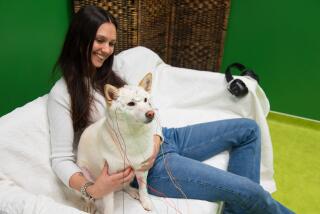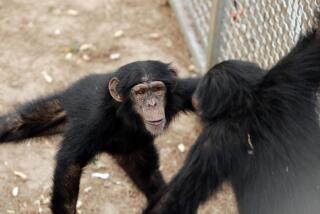Animals, Humans Take Similar Path on Memory Lane : Study Results Indicate That Storage Process Is More Complex Than Some Experts Thought
The mechanisms by which information is processed into memories are similar or identical in animals and humans, according to a new study that is expected to make scientists more confident that animal research can shed light on how memory works in man.
The results also indicate that the process of memory storage is more complex than some scientists had believed.
The study, reported in a recent issue of the journal Science by Anthony A. Wright and his colleagues at the University of Texas Health Science Center in Houston, dealt with a phenomenon known as a U-shaped serial function. That function “has been thought to be a benchmark in studies of memory processing since 1885,” Wright said in a telephone interview. The results indicate that the U-shaped function appears because of the way scientists had conducted previous studies.
The U-shaped serial function describes the ability of a subject to remember items in a list. The subject might, for example, be shown a series of slides, then be shown a single slide and asked if it was part of the series.
Typically, the number of correct responses will be highest for the first and last slides in the series. If the investigator plots the percentage of correct responses against the slide’s position in the series, a U-shaped curve results.
Pigeons, Monkeys, Humans
Wright and his co-workers showed a series of four travel slides to pigeons and monkeys and four slides of kaleidoscope images to humans. Each subject was then shown a single slide and required to indicate whether it had been part of the series. A different series of slides was used for each trial.
Humans and monkeys indicated their answers by moving a lever to the left or right, pigeons by pecking at a green or red disk in front of them. The animals were rewarded with food for correct answers.
Most investigators who have conducted such studies have not controlled the interval between the end of the series and the slide to be identified, and they have seen a U-shaped function. Wright showed the final slide at set intervals after the end of the series and obtained different results.
“When the subjects were tested immediately after the series, they remembered only the last slides in the series,” he said. “At later intervals, they remembered the first and last slides, giving the normal U-shaped function. At still later intervals, they remembered only the first slides in the series.”
In other words, the U-shaped function appeared only temporarily during the memory process. This phenomenon had not been observed before.
The patterns were virtually identical for all three species. “The only difference is that the process occurred faster for the animals,” Wright said. “The whole sequence of changes in the serial function took place in about 10 seconds for pigeons, 30 seconds for monkeys and 120 seconds for humans.”
“Wright’s results are dramatic evidence that memory processing in animals is similar or identical to that in humans,” said psychologist Robert G. Crowder of the Yale University School of Medicine.
Wright’s work may provide the clinching evidence against the once-popular theory that information must first be stored in short-term memory. Repetition in the short-term memory, a process known as “rehearsal,” causes information to be transferred to long-term memory, according to the theory.
Many Ways to Get Information Into Memory
“If information reaches long-term memory through rehearsal, then it has to be in short-term memory first,” said Michael J. Watkins, a psychologist at Rice University in Texas. “The fact that subjects did not remember the first item in the series immediately indicates that the information is not in short-term memory but elsewhere.”
Wright does not propose a new theory of memory processing, and it may be that no single theory will explain all of the available evidence. “What is becoming increasingly clear,” Crowder said, “is that there are as many different ways of getting information into memory as there are of acquiring information.”





